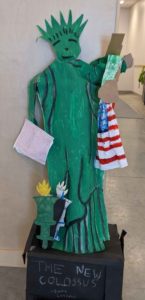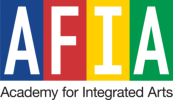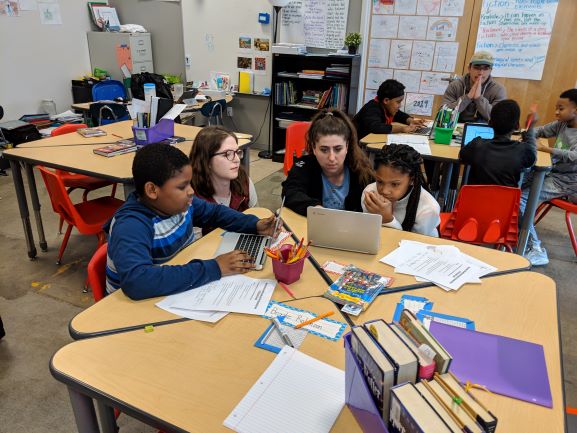By Keyonia Cobbins and Tricia DeGraff
At AFIA, we believe children’s questions should be central to learning and project work. We also believe it is important for students to learn about complex issues so that they are better positioned to make change.
We often use high quality read-alouds by diverse authors to build content knowledge and provide opportunities for students to wonder and ask questions. We also partner with local organizations and bring in field experts, as we believe students should have opportunities to learn from local experts. A great example of a project that highlights these elements is “The Troost Divide Project” that spanned two school years.
How The Project Began
This project began with a book Mrs. Cobbins read to her students by Patricia Palacco, Pink and Say. This historical fiction narrative is about two people from different backgrounds who became friends through their journey in the Civil War. During this interactive read aloud, the students became intrigued with the Civil War. Knowing that this topic fit well into the curriculum and sensing the students’ interest, Mrs. Cobbins gathered a host of books about the Civil War.
Prior to reading the books, Mrs. Cobbins carefully elicited students’ ideas about what they already knew about the Civil War and what they were interested in learning. She noticed students had a common interest in the Battle of Gettysburg.
Students discussed the question: What did the Battle of Gettysburg symbolize for our country? Their responses were amazing! Students metaphorically compared the Battle of Gettysburg to hope, the hope that our nation would not be divided by hatred.
Through reading, students learned that this battle was the turning point for the Union and for our nation. It was the bloodiest battle ever fought in the history of our nation, with over 100,000 casualties. Students became interested in Lincoln’s speech delivered on the battlefield. The Gettysburg Address became the next focus for the class as they engaged in an analytical reading of the speech.
Next, the students watched a documentary about the Battle of Gettysburg, guided by two-column notes with specific talking points which led to engaging discussions. Students were drawn to the reference of “unfinished work” that President Abraham Lincoln used in his address.
The students explored, “What is the unfinished work in America?” Their inquiry led students to compose a web of problems that are prevalent today. Some examples of those issues were: suicide, bullying, police brutality, gender equality, racial equality, and the list goes on. They brainstormed ways we can work as a community toward the improvement of our nation.
Leveraging Lessons from the Past To Explore The Troost Divide
To hit even closer to home, students explored issues present in our community and asked the question: “What is the unfinished work in Kansas City?” At that time, the class was reading a Feathers by Jacqueline Woodson. This book highlights injustices within communities due to dividing lines created because of differences in race, ethnicity and culture, socio-economics, stereotypes and biases. The teacher asked the students to reflect on the community in the story, and how it connects to the community in which we live.
This led to the study of what we call the “Troost Divide.” The students quickly learned that Troost, a street running from the north end to south end of Kansas City (in front of their own school), is a dividing line based on race, socio-economic status, education, marital status and income.
The class began their study of the Troost Divide with primary sources such as articles, news clippings and documentaries. They composed a web of “What We Know about the Divide-Past, Present and Future.”
Partnering with UMKC Mentors to Develop a Deeper Understanding of the Troost Divide
Mrs. Cobbins and her class were given an opportunity to work with University of Missouri Kansas City interns who were taking an honors course taught by Dr. Henri Wood and Dr. Stephen Christ: Public Urban Education.
The UMKC interns served as mentors to small groups of students as they engaged in a research project related to the Troost Divide. Students research topics such as: gerrymandering, reconciliation services, blockbusting, influential leaders and structural racism.

AFIA students work with UMKC students on their research projects about the Troost Divide.
This project provided opportunities to learn from local experts in Kansas City about issues that matter to the students and our community.
Students researched topics they developed in collaboration with the UMKC interns related to three overarching questions:
- What created the division in our city known as the Troost Divide?
- What are people doing to overcome this division known as the Troost Divide?
- What future actions can be taken by our community, including us, to overcome this division known as the Troost Divide.
An important part of the Project Approach is sharing your learning with your community. As fourth graders, each group of students presented a slide deck and shared their learning with community members and their families. Over thirty community members visited AFIA to learn from our students. Students dressed for the occasion and shared their research with pride.

Students presented their research to the community
The following year, our students were invited to share their learning with another audience by co-presenting with Dr. Wood and Dr. Christ in the FaCET UMKC & Rockhurst Fall 2019 Conference: Reflections on Education, Equity and Integrated Communities.
Continued Learning and Deep Discussions about Equity
This learning continued into fifth grade. Students engaged in an analytical reading of the “New Colossus” by Emma Lazarus. There is a line in the poem that references the Statue of Liberty’s torch as a symbolic “world-wide welcome.” Students engaged in sophisticated discussions about whether or not everyone receives a world-wide welcome in the United States. Drawing from their previous project on the Troost Divide, students came to the conclusion that our communities are not welcoming like the country depicted by the Statue of Liberty.
To represent their learning, students created a sculpture of the Statue of Liberty, but instead of placing the torch in the statue’s hand, they carefully placed the torch at the base of the statue to symbolically represent their thoughts about today’s United States.

Students created this sculpture to share their learning.
Our students recently shared some of their ideas about why this project was important. Marlo said, “If we know what has happened in the past, and what people are doing to change it, we can stop things like that from happening in the future.”
Our students are passionate about unfinished work in our nation today. For example, Aatyis shared, “I can lead by example, not just telling people. When people see something being done they will do something too.”
And as Sychez shares:
We can make change
any day
any time
and anywhere
We are proud of our students for their commitment and work to make a difference in the world.
Academy for Integrated Arts is a PK – 6th arts integrated, public charter school. We believe children more deeply when they engage in the arts as part of the core curriculum. To learn more about our school, please visit: https://afiakc.org/.


Leave A Comment
You must be logged in to post a comment.